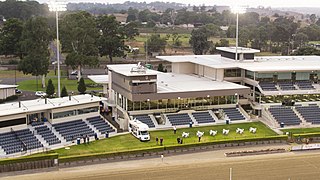Related Research Articles

Hoxton Park Airport was a general aviation aerodrome in south-western Sydney, New South Wales, Australia.

Camden Airport is an aerodrome located on the outskirts of Sydney 1 nautical mile northwest of Camden, New South Wales, Australia. The airport is located approximately 60 km (37 mi) from Sydney's central business district. Camden is used as a general aviation overflow airport for the busier Bankstown Airport; and provides facilities for gliding and ballooning. The aerodrome has one grass- and one paved runway and two glider airstrips. It is in the south-west corner of the designated Sydney flight training area.

Bathurst Airport is an airport serving Bathurst, New South Wales, Australia.
Mudgee Airport is an airport located 3 nautical miles north northeast of Mudgee, New South Wales, Australia. The airport is frequently used for technical training.

Evans Head Memorial Aerodrome is a heritage-listed airport in Evans Head, Richmond Valley Council, New South Wales. The airport is approximately 1 km (0.62 mi) north of the village. During World War II it was Royal Australian Air Force (RAAF) Station Evans Head supporting RAAF No 1 Bombing and Gunnery School (1BAGS) and subsequently the RAAF No 1 Air Observers School. At the height of operations there were three asphalt runways and one grass strip. Only a single asphalt strip is still in use by private aviation. It was added to the New South Wales State Heritage Register on 22 November 2002.
RAAF Station Schofields is a former Royal Australian Air Force (RAAF) military air base and aerodrome located at Schofields, a suburb of Sydney in New South Wales, Australia. The aerodrome was used during World War II and was in operation between 1942 and 1944.
Cessnock Airport is a civil airport located 6 km (4 mi) North of Cessnock, New South Wales, Australia.
Fleurs Aerodrome was a parent aerodrome built on behalf of the Royal Australian Air Force during World War II. It is located at Kemps Creek 40 km west of Sydney, Australia

Tabcorp Park, Menangle, is a harness racing track operating in Menangle Park, New South Wales, Australia. The New South Wales Harness Racing Club conducts meetings at the Paceway. The New South Wales Harness Racing Club trading as Club Menangle Trackside is located within the Paceway grounds. Major extensions to the club at the licensed historic premises previously known as the Horse and Jockey Inn just outside the paceway grounds, opened in September 2019.
Marsden Park Aerodrome was an aerodrome constructed by the Royal Australian Air Force (RAAF) in Berkshire Park, near Marsden Park, New South Wales during World War II.
RAAF Base Nabiac was an advanced operating base for the Royal Australian Air Force (RAAF), during the Second World War, near Nabiac, New South Wales, Australia. Constructed in 1942 by the NSW Public Works Department 10 km (6.2 mi) to the south east of Nabiac. The aerodrome consisted of four runways, with associated bomb dumps and camouflaged hangars for the Avro Anson and Douglas Boston aircraft stationed at the aerodrome. The base was closed after the war and fell into disuse. New England Airways later commenced a passenger and freight service and later Butler Air Transport then took over operations until 1952, when Wallis Island Aerodrome at Forster was opened.
Dungog Aerodrome was an aerodrome constructed in 1942 by the Royal Australian Air Force as a satellite aerodrome east of Wallarobba, New South Wales, Australia during World War II.
Warkworth Aerodrome is an aerodrome constructed in 1942 by the Royal Australian Air Force as a satellite aerodrome north of Warkworth, New South Wales, Australia during World War II.
RAAF Station Bulga was an aerodrome constructed in 1942 by the Royal Australian Air Force north of Bulga, New South Wales, Australia during World War II.
Strowan Aerodrome was an aerodrome constructed in 1942 by the Royal Australian Air Force as a satellite aerodrome west of Jerrys Plains, New South Wales, Australia during World War II.
Glendon Aerodrome was an aerodrome constructed in 1942 by the Royal Australian Air Force as a satellite aerodrome near Glendon, New South Wales, Australia during World War II.
Ringwood Aerodrome was an aerodrome constructed in 1942 by the Royal Australian Air Force as a satellite aerodrome near Eagleton, New South Wales, Australia during World War II.
The Oaks Airfield is an unlicensed private airfield located in The Oaks, New South Wales in the Wollondilly Shire, west of Sydney Australia. Originally built by the Royal Australian Air Force (RAAF) during World War II, today the airfield caters mostly to recreational aircraft and flight training and is home to Dave's Flying School and the Sydney Recreational Flying Club. The airfield is a heritage listed site and is the only airport constructed during WWII to still be operational. Other airfields from the time in Sydney have either being converted or demolished.

Marske Aerodrome was a First World War-era airfield used by the Royal Flying Corps, and later by the Royal Air Force, between 1917 and 1920. The aerodrome was just to the west of the village of Marske-by-the-Sea in Yorkshire, England. Marske aerodrome hosted air gunnery schools and trained pilots in tactics and methods of aerial combat so that they could be deployed to the front. Marske is known for being the aerodrome where W. E. Johns, author of the Biggles books, undertook his training, as well as being noted for some of the flying instructors who were famous among the aircrew cadre.
References
- ↑ "Appendix F – World War II Aerodromes and Landing Grounds in NSW" (PDF). NSW Heritage Office. Archived from the original (PDF) on 21 March 2012. Retrieved 12 April 2012.